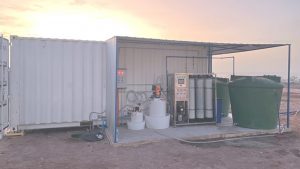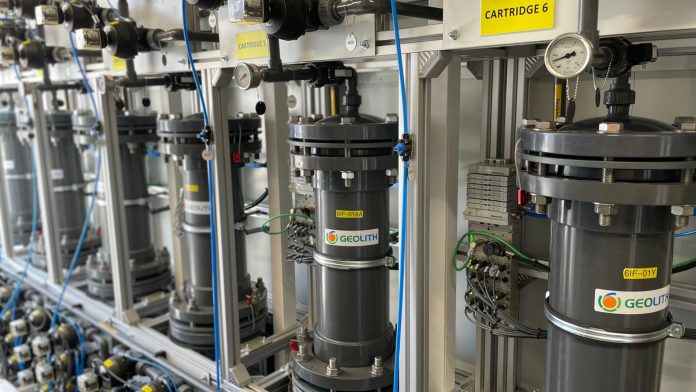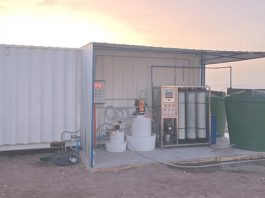In an increasingly critical landscape, industrialising DLE technology will be cornerstone to succeeding in the energy transition. GEOLITH will be a major actor with its Li-Capt® technology.
Direct Lithium Extraction (DLE) technology is applicable to any liquid source of lithium. It brings to the market a disruptive technology that enables the success of energy transition agendas. It allows for local and sustainable lithium production, as well as securing the supply of this critical material for electric mobility worldwide.
These technologies, like GEOLITH’s Li-Capt®, bring several technical and environmental advantages, which make them extremely appealing for traditional lithium producers from brines in the Lithium Triangle. These lithium producers are increasingly researching DLE applications, and most have clear adoption plans.
Moreover, thanks to the enhanced productivity of these technologies compared to evaporation, they allow diversification of production sources, opening new market opportunities in less concentrated salars, geothermal, oil-produced waters, and several industrial waste streams.
Lithium mining in South America
The traditional lithium market from brines is in South America, mainly in the Lithium Triangle, which covers Chile, Argentina, and Bolivia. The continent alone accounts for 62% (Albermale, Fastmarkets) of the world’s lithium resources (according to Albemarle’s report issued in 2023).
Every producing country in South America is currently defining its lithium strategy. This is, for them, an excellent opportunity to gain competitiveness and become focal actors in a huge global market like battery manufacturing. Their strategies need to be adapted to suit a new market landscape by adopting new extraction methods, including DLE.
Every country faces different political and economic realities, but they share common objectives: to safeguard their natural resources and to ensure sustainable development for their communities and economies. DLE technology is becoming a cornerstone in their strategies when it comes to lithium production.
Chile is a good example of how DLE shapes the new lithium landscape. Currently, it is the world’s leading lithium producer from brines. Two major companies share the market (SQM and Albemarle) thanks to operation licences obtained until 2030 for the former and 2043 for the latter. However, several junior mining companies are gradually developing projects as a result of the opportunities that DLE technology opens. This technology enables production from smaller, less concentrated resources. It is a whole new market.
The Chilean government, headed by Gabriel Boric, recently announced (in April 2023) the implementation of a National Lithium Strategy. The current administration intends to leverage the country-leading position to ensure better public-private collaboration and enhance the ecological performance of lithium extraction. DLE is mentioned in the National Lithium Strategy as a crucial element, and several members of the administration, including President Boric and Minister of Mining Madame Marcela Hernando, visited GEOLITH’s pilot plant earlier this year in Antofagasta, Chile.
Almost every developer in the country has announced DLE strategies, including state-owned CODELCO (which has been appointed to lead the creation of a fully-fledged lithium company), showing not only the government interest, but also the industry’s willingness to adopt these technologies.
DLE is also proving to be a great catalyser of project development in the rest of the countries known to form the Lithium Triangle. These countries have traditionally weaker production than Chile due to several factors related to the concentration in lithium of the salars, the climate conditions, and the development of the value chain.
Since 2018, Argentina’s lithium production has stabilised at around 35,000 tons (Fastmarkets, Commercial Outlook, June 2023), but thanks to DLE technology, it has the potential to double (even more) its production in the immediate future. As a matter of fact, Argentina hosts the most advanced DLE projects in South America, including Livent and Eramet. With a significant project pipeline and having been successful in securing foreign investment, Argentina is leveraging DLE to foster a strong local lithium value chain.
In Bolivia, the country with the largest estimated lithium resources, YLB has been publicly testing different DLE technologies for its implementation in the assets of the state-owned company.

New opportunities delivered through DLE technology
Moreover, DLE technologies are also opening new markets. Thanks to a more selective extraction, DLE opens the door to producing lithium from brines at low concentrations, from local sources in regions that are not traditional lithium producers. In particular, important resources have been identified in oil produced and geothermal waters across the globe. Producing from these assets, which in most cases already exist, will help reduce dependency over this critical material in these regions, like Europe and North America.
Geothermal emerged as a renewable energy source for heat and electricity production. However, its profitability has been questioned due to the high investment needs and operating costs. DLE brings the opportunity of complementary revenue at moderate costs, enhancing the economic viability of the assets, but most importantly, leveraging the renewable energy produced in the asset to achieve a truly carbonless lithium.
More advantages come from producing near the final customer, reducing logistics and better adapting to the technical specifications of the battery manufacturers. Geolith has been testing these sources for years in Europe, thanks to its pilot plants, with solid results, validating both the technical and economic feasibility of producing lithium from these assets.
The case is quite similar for oil-produced waters. Installing DLE in existing assets will not only drive down the implementation costs but also give a second life to industrial infrastructure that will transition for oil-producing wells to lithium mines, further accelerating the ambitions of transition of the producing companies. This reinforces the capacity to produce lithium from local resources, as well as enjoying great technical synergies with an industry that has developed huge expertise in the extraction, treatment, and reinjection of underground fluids.
GEOLITH has tested several oil-produced waters in Europe and the US, confirming the technical and economic advantages of equipping oilfields with its DLE Li-Capt technology, bringing a new revenue stream to oil producers.
With its Li-Capt technology, Geolith has been testing geothermal and oil-produced brines in Europe for several years from sources in Europe and the US, thanks to its pilot plants, one of which is specifically designed to operate in geothermal assets, and has proven that Li-Capt® is able to operate under pressure and at high temperatures.
DLE is helping to solve supply challenges across the globe
DLE technology is becoming a topic of international politics. We have seen previously in this article how South American governments have included DLE in their strategies. In addition, The European Union and North America are facing challenges in the supply of raw materials such as lithium, and DLE is part of their strategies. Europe has seen the emergence of the Green Deal as well as the Critical Raw Materials Act, plus several country-based strategies (France, Germany, and the UK). The US has both government and federal strategies, and the Inflation Reduction Act (IRA) set up by the United States ($370bn) (IRA, US) has given a real boost for investments to secure the supply of raw materials. Both are financing lithium production projects in their regions that can be viable only by using DLE technologies such as GEOLITH’s Li-Capt, which will be crucial in achieving the desired results.
Moreover, Europe has engaged in strong diplomatic discussions with lithium-producing countries to strengthen collaboration throughout the whole lithium value chain. Ursula van der Leyen’s tour of Latin America in June 2023, followed by several European Heads of State, clearly demonstrates the desire to secure supplies of raw materials while ensuring sustainable development in the producing regions.
However, with a growing interest in exploiting lithium from these sources, the challenge is upscaling those facilities to industrial production levels. For that reason, GEOLITH is currently commissioning its pre-industrial manufacturing facilities in Europe – the first step of an ambitious industrial ramp-up designed to support its customers in their need for DLE technology for the years to come. With technical performances validated over the past few years, GEOLITH will be able to manufacture and supply as much DLE equipment as will be required by its customers from 2024 onwards, ensuring high standards of quality and performance.
GEOLITH Li-Capt technology will set the basis for scalable lithium production from local sources, with higher standards of environmental performance, ensuring no emissions, respect for the local communities, and a recyclable active material.
Please note, this article will also appear in the fifteenth edition of our quarterly publication.









